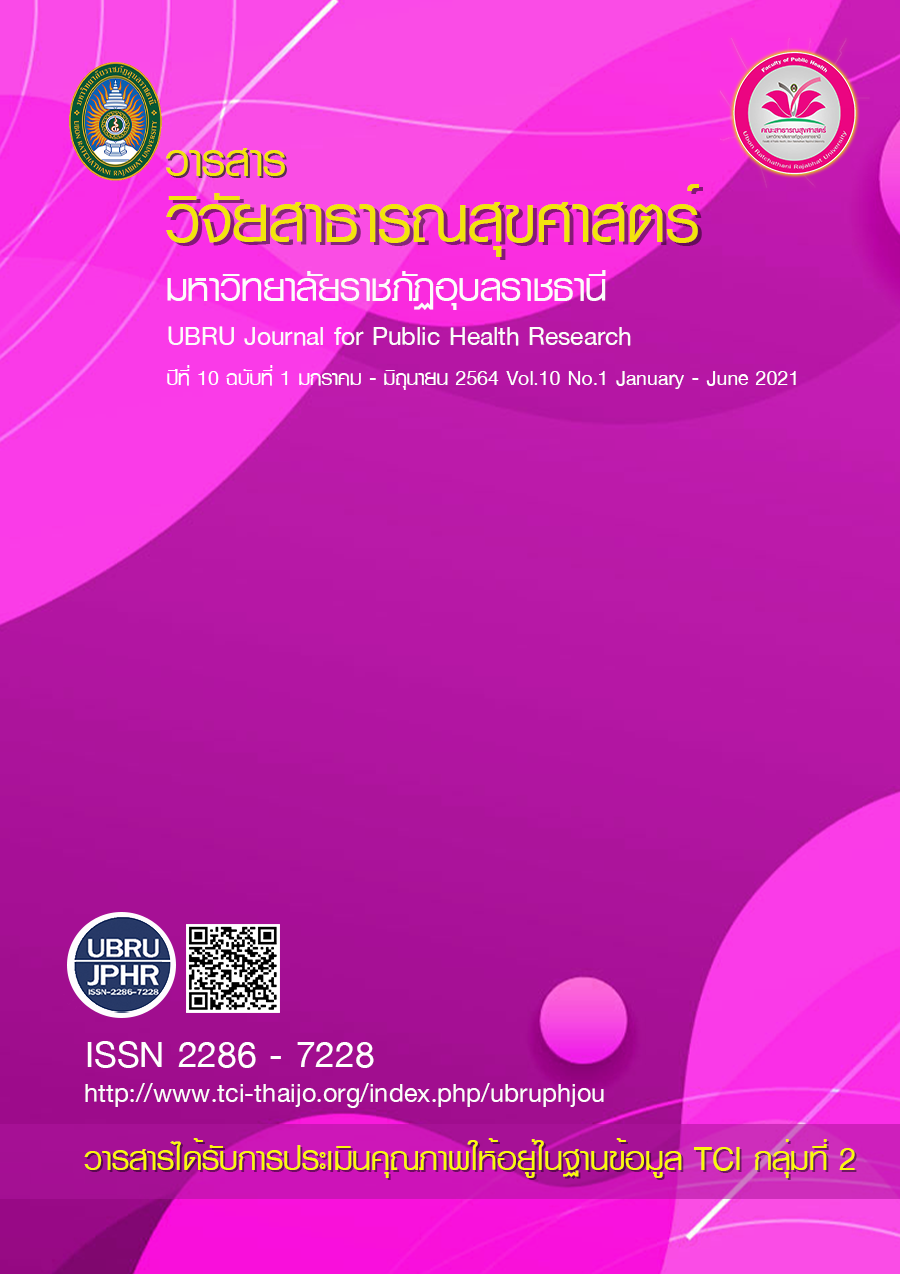The development model of participative health promoting for health impact management at health risks from secondhand smoke in community Kanthararom District, Sisaket Province
Keywords:
health promoting by participation, health impact management, secondhand smoke, Non-Smokers’ Health ProtectionAbstract
These development model of participative health promoting for health impact management at health risks from secondhand smoke in community. Enhancing smoking-free community by participatory in community to investigate solution and development a form of policy guideline and strategic action plan to promotion health and protection health for helping non smoker and reduced health risks from secondhand smoke in community and development smoking-free community by participatory. This Action Research was aimed to study model development model of participative health promoting for health impact management at health risks from secondhand smoke in community. The Scope of study consisted 3 phase and using action PAOR Spiral cycle in 6 weeks. The subject of the study is consisted of 45 persons and obtained using the purposive sampling technique. The research tools used a questionnaire and obtained using a structured interview questions by Action planning Method. The collected data were analyzed using percentages, means, standard deviations, paired samples T-test and using a content Analysis from an interview.
The research revealed that findings after development model of participative health promoting for health impact management at health risks from secondhand smoke in community in terms of knowledge, attitude, behavior, satisfaction and participation were statistically significant at p < 0.05.
In conclusion, the development model of participative health promoting for health impact management at health risks from secondhand smoke in community. Showed the succeeded factors and reduction of health risks from secondhand smoke in community by strategic action plan and a policy guideline from implementation and Participation by stakeholder. The research also showed improvement of knowledge, attitude, behavior, satisfaction and participation after participative management in smoking-free community policy campaign. The samples are already on the responded positively to of State Laws enforcement the Non-Smokers’ Health Protection Act, B.E. 2535. However, Finally success factors are from participation actually in solutions to awareness health risks from secondhand smoke and set barrier between a smoker and non smoker by smoking areas.
References
กัลยาวีร์ อนนท์จารย์ และคณะ. (2561). การลดพฤติกรรมการดื่มเครื่องดื่มแอลกอฮอล์ในชุมชน. วารสารวิจัยสาธารณสุขศาสตร์ มหาวิทยาลัย ราชภัฏอุบลราชธานี. 7(1): 15-21.
กิตติศักดิ์ เมืองหนู. (2544). ประสิทธิผลของโปรแกรมสุขศึกษาในการเลิกสูบบุหรี่ของผู้นำชุมชน อำเภอเมือง จังหวัดพัทลุง. วิทยานิพนธ์ปริญญาวิทยาศาสตรมหาบัณฑิต สาขาวิชาเอกสุขศึกษาและพฤติกรรมศาสตร์ บัณฑิตวิทยาลัย มหาวิทยาลัยมหิดล.
งามนิตย์ ราชกิจ และเรือนทอง ใหม่ศรินทร์. (2547). การขยายผลการพัฒนาระบบสร้างเสริมความ ปลอดภัยรถรับส่งนักเรียนในเขตชนบท จังหวัดเชียงราย. นนทบุรี: สถาบันวิจัยระบบสาธารณสุข.
เชษฐ รัชดาพรรณาธิกุล และกฤษฎา แสงเจริญทรัพย์. (2556). สาระสำคัญและข้อสังเกตบางประการ ตาม พระราชบัญญัติป้องกันและปราบปรามการค้ามนุษย์ (ฉบับที่ 2). วารสารกระบวนการ ยุติธรรม สำนักงานกิจการยุติธรรม. 8, 1-12.
ทัศนีย์ ผลชานิโก. (2558). แผนยุทธศาสตร์การควบคุมยาสูบแห่งชาติฉบับที่ 2 พ.ศ.2558-2562. กรุงเทพฯ: กรมประชาสัมพันธ์.
ธนภัทร ศรีวะรมย์. (2561). การพัฒนาบทบาทสตรีในการเสริมสร้างชุมชนปลอดบุหรี่ ผ่านกระบวนการวางแผนแบบมีส่วนร่วม กรณีศึกษา: ตำบลปาฝา อำเภอจังหาร จังหวัดร้อยเอ็ด. วารสารวิจัยสาธารณสุขศาสตร์ มหาวิทยาลัยราชภัฏอุบลราชธานี. 7(2), 85-94
ธนะพัฒน์ ทักษิณทร์. (2553). ความรู้ ทัศนคติและพฤติกรรมต่อพระราชบัญญัติคุ้มครองสุขภาพของผู้ที่ไม่สูบบุหรี่ พ.ศ. 2535 ของผู้มาใช้บริการสถานีขนส่งจังหวัดมหาสารคาม อำเภอเมือง จังหวัดมหาสารคาม คณะ สาธารณสุขศาสตร์ มหาวิทยาลัยมหาสารคาม.
ธวัชชัย วรพงศธร. (2543). หลักการวิจัยทางสาธารณสุขศาสตร์. พิมพ์ครั้งที่ 4. กรุงเทพฯ: โรงพิมพ์แห่งจุฬาลงกรณ์มหาวิทยาลัย.
ผ่องศรี ศรีมรกต และรุ้งนภา ผาณิตรัตน์. (2550). การวิจัยเชิงปฏิบัติการแบบมีส่วนร่วมเพื่อพัฒนารูปแบบการเสริมสร้างความตระหนักในพิษภัยบุหรี่สำหรับเยาวชนไทย. วารสารพยาบาล. 56, 49-61.
ไพศาล ลิ้มสถิต. (2556). การศึกษาความสำคัญของ WHO FCTC มาตรา 5.3 ต่อการควบคุมยาสูบของประเทศไทย. กรุงเทพฯ: ศูนย์วิจัยและจัดการความรู้เพื่อการควบคุมยาสูบ คณะสาธารณสุขศาสตร์ มหาวิทยาลัยมหิดล.
มณฑา เก่งการพานิช, ศรัณญา เบญจกุล, ธราดล เก่งการพานิช, ลักขณา เติมศิริกุลชัย และภิฤดี ภวนานนท์. (2555). พฤติกรรมการสูบบุหรี่ผิดกฎหมายของผู้สูบบุหรี่ปัจจุบันในภาคใต้ของไทย. ศูนย์วิจัยและจัดการความรู้เพื่อการควบคุมยาสูบ. กรุงเทพฯ: ศูนย์วิจัยและจัดการความรู้เพื่อการควบคุมยาสูบ คณะสาธารณสุขศาสตร์ มหาวิทยาลัยมหิดล.
ศูนย์วิจัยและจัดการความรู้เพื่อการควบคุมยาสูบ. (2555). สรุปสถานการณ์ปัจจัยเสี่ยงหลักด้านยาสูบของประเทศไทย พ.ศ. 2555. กรุงเทพฯ: เจริญดีมั่งคงการพิมพ์ เขตภาษีเจริญ.
ศูนย์วิจัยและจัดการความรู้เพื่อการควบคุมยาสูบ. (2559). สถานการณ์การควบคุมการบริโภคยาสูบ ของประเทศไทย พ.ศ. 2559. กรุงเทพฯ: เจริญดีมั่นคงการพิมพ์.
ศูนย์วิจัยและจัดการความรู้เพื่อการควบคุมยาสูบ. (2560). สายด่วนเลิกสูบบุหรี่. Retrieved June 6, 2019, from http://www.trc.or.th/th/ index.php?option=comcontent&view=article&id=415&Itemid=1139.
สนอง คล้ำฉิม. (2551). ความสัมพันธ์ระหว่างการรับรู้อันตรายจากควันบุหรี่มือสองกับพฤติกรรม สุขภาพของสมาชิกครอบครัวที่มีผู้สูบบุหรี่. นครปฐม: มหาวิทยาลัยศิลปากร.
สมจิต แดนสีแก้ว, สมศักดิ์ ศรีสันติสุข, เอื้อมพร ทองกระจาย และพีระศักดิ์ ศรีฤๅชา (2548). การขับเคลื่อนชุมชนเพื่อต่อสู้กับยาเสพติดในภาคตะวันออกเฉียงเหนือประเทศไทย. วารสารวิจัยทางการพยาบาล. 9 (3), 141-154.
สำนักงานสถิติแห่งชาติ. (2559). สถานการณ์ความสำคัญ และแผนยุทศาสตร์การควบคุมยาสูบ. กรุงเทพฯ: สำนักงานสถิติแห่งชาติ.
สำนักงานสถิติจังหวัดศรีสะเกษ. (2561). การสำรวจพฤติกรรมการสูบบุหรี่และการดื่มสุราของประชากร พ.ศ.2561. สำนักงานสถิติแห่งชาติ.
อังคณา วนาอุปถัมภ์กุล. (2552). ผลของโปรแกรมส่งเสริมการเลิกบุหรี่ที่ประยุกต์ใช้ทฤษฎีขั้นตอน การเปลี่ยนแปลงพฤติกรรมร่วมกับแรงสนับสนุนทางสังคมในผู้ป่วยวัณโรค. กรุงเทพฯ: มหาวิทยาลัยมหิดล.
องอาจ นัยพัฒน์. (2548). วิธีวิทยาการวิจัยเชิงปริมาณและคุณภาพทางพฤติกรรมศาสตร์และสังคมศาสตร์. กรุงเทพฯ: มหาวิทยาลัยศรีนครินทร วิโรฒ.
Jirawoot Kujapun et al. (2562). Factors related to perception of secondhand smoking damage of students in private university. UBRU Journal for Public Health Research. Faculty of Public health. Ubon Ratchathani Rajabhat university. 8(1), 105-109.
US Environmental Protection Agency. (1992). Environmental Equity Workgroup. Environmental Equity: Reducing Risk for All Communities: Report, 2. U.S.: Environmental Protection Agency, Office of Policy, Planning and Evaluation.
Downloads
Published
How to Cite
Issue
Section
License
เนื้อหาและข้อมูลในบทความที่ลงตีพิมพ์ในวารสารวารสารวิจัยสาธารณสุขศาสตร์ มหาวิทยาลัยราชภัฏอุบลราชธานี ถือเป็นข้อคิดเห็นและความรับผิดชอบของผู้เขียนบทความโดยตรงซึ่งกองบรรณาธิการวารสาร ไม่จำเป็นต้องเห็นด้วย หรือร่วมรับผิดชอบใดๆ
บทความ ข้อมูล เนื้อหา รูปภาพ ฯลฯ ที่ได้รับการตีพิมพ์ในวารสารนี้ ถือเป็นลิขสิทธิ์ของวารสารฯ หากบุคคลหรือหน่วยงานใดต้องการนำทั้งหมดหรือส่วนหนึ่งส่วนใดไปเผยแพร่ต่อหรือเพื่อกระทำการใดๆ จะต้องได้รับอนุญาตเป็นลายลักอักษรณ์จากบรรณาธิการวารสารนี้ก่อนเท่านั้น


